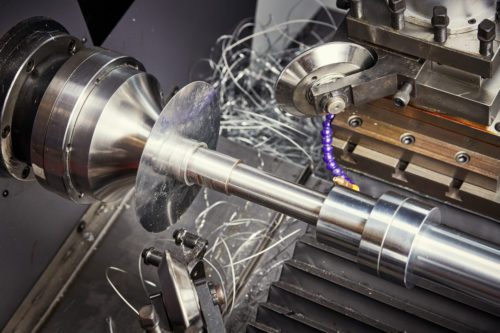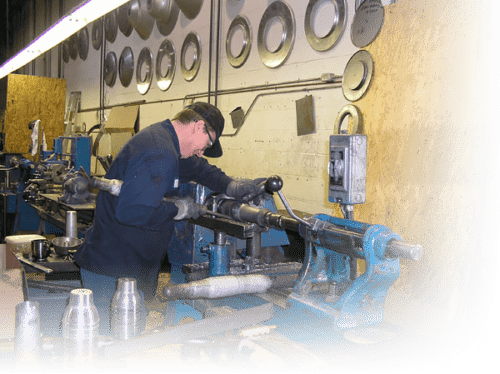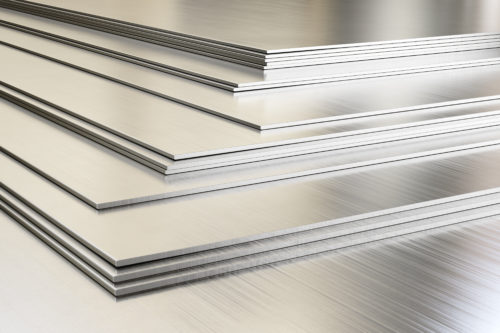Hand Spinning vs. CNC Spinning
Comments Off on Hand Spinning vs. CNC SpinningMetal spinning is a rimless metalworking technique that stretches back from the era of artisans and craftsmen in the past to today’s mass manufacturers. While techniques in the past were forged in manual work, modern processes use a combination of both hand spinning and processes governed by CNC machinery. By rotating a metal workpiece at high speeds around a fixed axis, metal-spinning tools can cut and shape the metal into an axially symmetrical product. In mass manufacturing, the first stages of metal spinning are completed by automated machines before being finished by hand. This process is popular across multiple different industries.
In this guide, learn more about the similarities, differences, and applications of both hand spinning and CNC spinning processes.
Hand Spinning vs. CNC Spinning: Similarities
 Both hand and CNC spinning operate off of the same basic principles. They transform workpieces of metal into a range of shapes, such as tubes, bell-shaped parts, and spherical components along a fixed axis of symmetry. Both processes are also fast, which make them especially advantageous for creating prototypes.
Both hand and CNC spinning operate off of the same basic principles. They transform workpieces of metal into a range of shapes, such as tubes, bell-shaped parts, and spherical components along a fixed axis of symmetry. Both processes are also fast, which make them especially advantageous for creating prototypes.
In fact, spinning is one of the fastest processes for forming metal goods; other popular processes such as metal stamping can’t keep up. This increases the efficiency of spinning-based production processes, as does the minimal amount of waste the process creates.
Hand Spinning vs. CNC Spinning: Differences
 Hand and CNC-spinning processes do have some crucial differences that you can use to determine which is the right fit for your next project.
Hand and CNC-spinning processes do have some crucial differences that you can use to determine which is the right fit for your next project.
Hand spinning is a much more manual process than its modern CNC alternative. The technician controls the spinning speed while operating forming forces to produce the final shape. This allows for fine-tuned control and artistry. It’s also more cost-effective for the production of prototypes, unique pieces, and small-volume orders.
Because hand operators exert less force on the metal, it also tends to be used with fragile or ductile metal that need a more delicate touch like O-tempered aluminum and some stainless steels. It’s also the preferred choice for precious and semi-precious metals.
CNC-metal spinning, on the other hand, is controlled predominantly by automated CNC machinery. These machines interpret instructions from a design file and follow those strict steps to create virtually identical part after part. The machinery controls hydraulic presses that force the metal workpiece into shape, and it determines how long the hydraulics are engaged and how fast the workpiece spins. It offers complete accuracy in a way manually controlled processes can’t guarantee.
Because of this consistency, CNC spinning is the preferred choice for manufacturing products that need high volumes of identical parts within strict tolerances. CNC machinery can also exert more force through the hydraulic presses, making it a superior choice for hard materials that are difficult to form. However, it can also handle metals with >2% ductility.
Hand Spinning vs. CNC Spinning: Applications
Hand-spinning processes commonly form these products:
- Beverage can prototypes
- Satellite parts
- Aircraft parts
- Semiconductor manufacturing equipment parts
- Antennas
CNC spinning processes are used to form large volumes of high-precision products in these industries:
- Aerospace
- Automotive
- Clothing
- Food and beverage
- Healthcare
- Military components
- Mining
Contact Us at Metal Craft S&S for High-Quality Metal Spinning
Both hand spinning and CNC spinning processes can craft high-quality metal products across multiple different industries. At Metal Craft S&S, we offer hand spinning and CNC spinning services. Contact us today to learn more about our capabilities or request a quote for pricing details.
Galvanized Steel vs. Stainless Steel: Which Is the Better Choice?
Comments Off on Galvanized Steel vs. Stainless Steel: Which Is the Better Choice?Both stainless steel and galvanized steel are strong and durable, but each one has specific advantages, depending on the application. When it comes to galvanized steel vs. stainless steel, you have to understand the difference between the two and consider what type of product you’re making and what demands it will face in its environment. From there, the best choice for you will become clear.
What Is Galvanized Steel vs. Stainless Steel?

Galvanized steel is coated with zinc to protect it from rust, while stainless steel is an alloy made with at least 10% chromium for the same reason: to guard against rust and corrosion. There are several types of stainless steel, each determined by the type and amount of additional materials, like chromium, as well as nickel, titanium, manganese, and/or molybdenum, present in the steel:
- Austenitic stainless steel
- Ferritic stainless steel
- Long-wearing martensitic steel
- Duplex stainless steel
- Precipitation-hardening stainless steel
Benefits & Drawbacks of Galvanized Steel vs. Stainless Steel
The strengths and weaknesses of each type of steel will help you determine whether it’s right for your application:
Galvanized Steel
 Galvanized steel is water-resistant, but it does not hold up well under salt water. When compared to stainless steel, it’s easier to work with and much less expensive. For many construction applications, galvanized steel is a trusted, economical choice, as long as it won’t be in contact with salt water.
Galvanized steel is water-resistant, but it does not hold up well under salt water. When compared to stainless steel, it’s easier to work with and much less expensive. For many construction applications, galvanized steel is a trusted, economical choice, as long as it won’t be in contact with salt water.
However, one drawback is in the welding process: the zinc coating releases toxic fumes that can contribute to flu-like symptoms and discomfort, so it’s important for welders to have the proper protective equipment. Because welding removes the zinc in the welding area, that area is subject to corrosion. In many situations, it may be preferable to galvanize the steel after the welding process is complete.
Stainless Steel
 Exceptionally strong and rust-resistant, stainless steel withstands contact with both fresh and salt water—but not chlorinated water, which will cause the steel to degrade quickly. It offers more corrosion resistance than galvanized steel, making it a great choice for marine and aerospace applications.
Exceptionally strong and rust-resistant, stainless steel withstands contact with both fresh and salt water—but not chlorinated water, which will cause the steel to degrade quickly. It offers more corrosion resistance than galvanized steel, making it a great choice for marine and aerospace applications.
One major drawback is the cost: stainless steel can be about five times more expensive than galvanized steel. It also requires highly skilled welders with exceptional patience and control. Further, stainless steel can weld itself together if two pieces are in contact and the friction rubs through the coating, which could be a concern in certain applications.
Applications of Galvanized Steel vs. Stainless Steel
Hinges, gaskets, and fasteners like nuts, bolts, screws, and nails are often made of galvanized steel to withstand extreme weather conditions. In high-moisture environments, like automobile exhaust pipes, marine applications, and the aerospace industry, stainless steel is typically the best choice.
Choosing between galvanized and stainless steel comes down to your application. For example, galvanized steel is not effective in marine applications. In that situation, stainless steel is essential.
However, in most circumstances, galvanized steel is going to be the more economical option. Materials and labor are both more affordable, and you can still depend on galvanized steel’s strength and long service life.
At Metal Craft Spinning & Stamping, we’ve been producing high-quality products for our clients for nearly 60 years. As a fourth-generation family-operated company, we’re committed to building long-term, trusted relationships with our clients by providing on-time delivery, a collaborative process, and a personalized approach to every project. Request a quote today, or contact us to learn more about our products and services and whether galvanized steel or stainless steel is best for your project.



